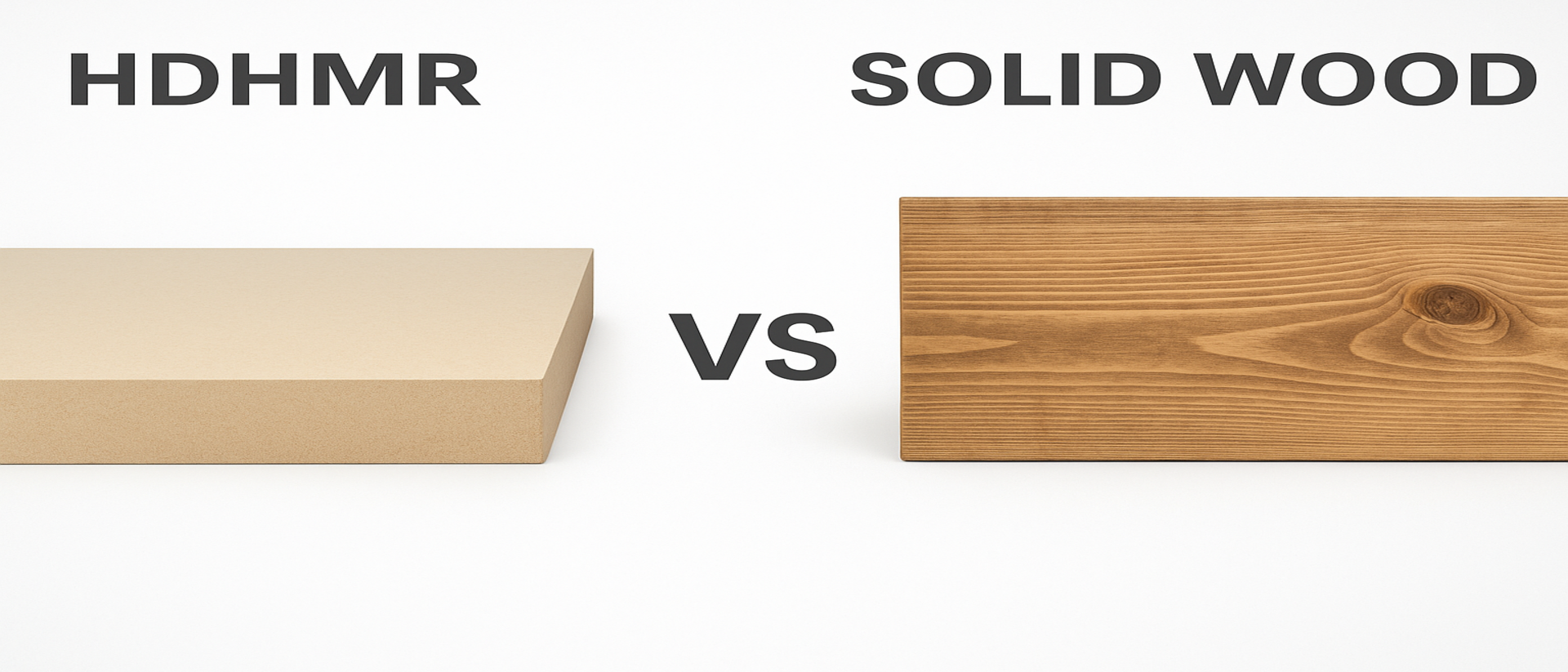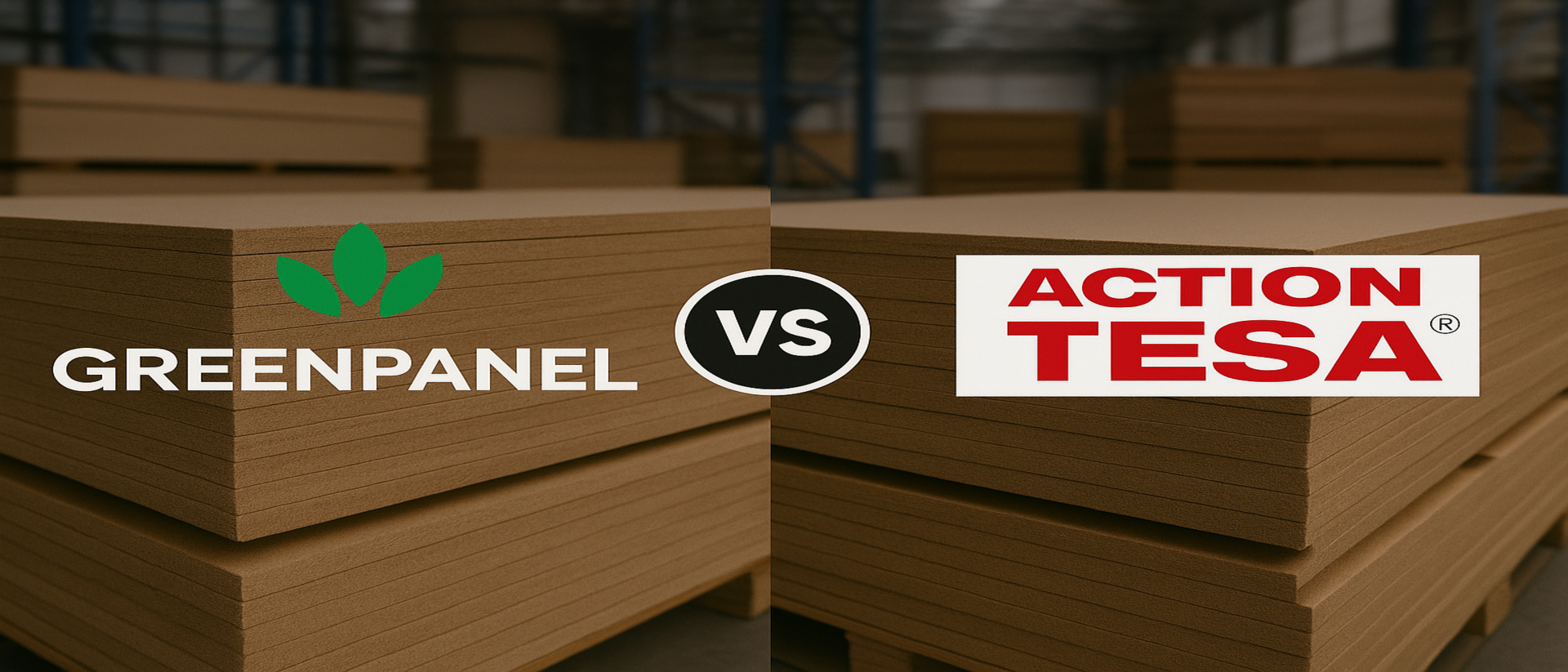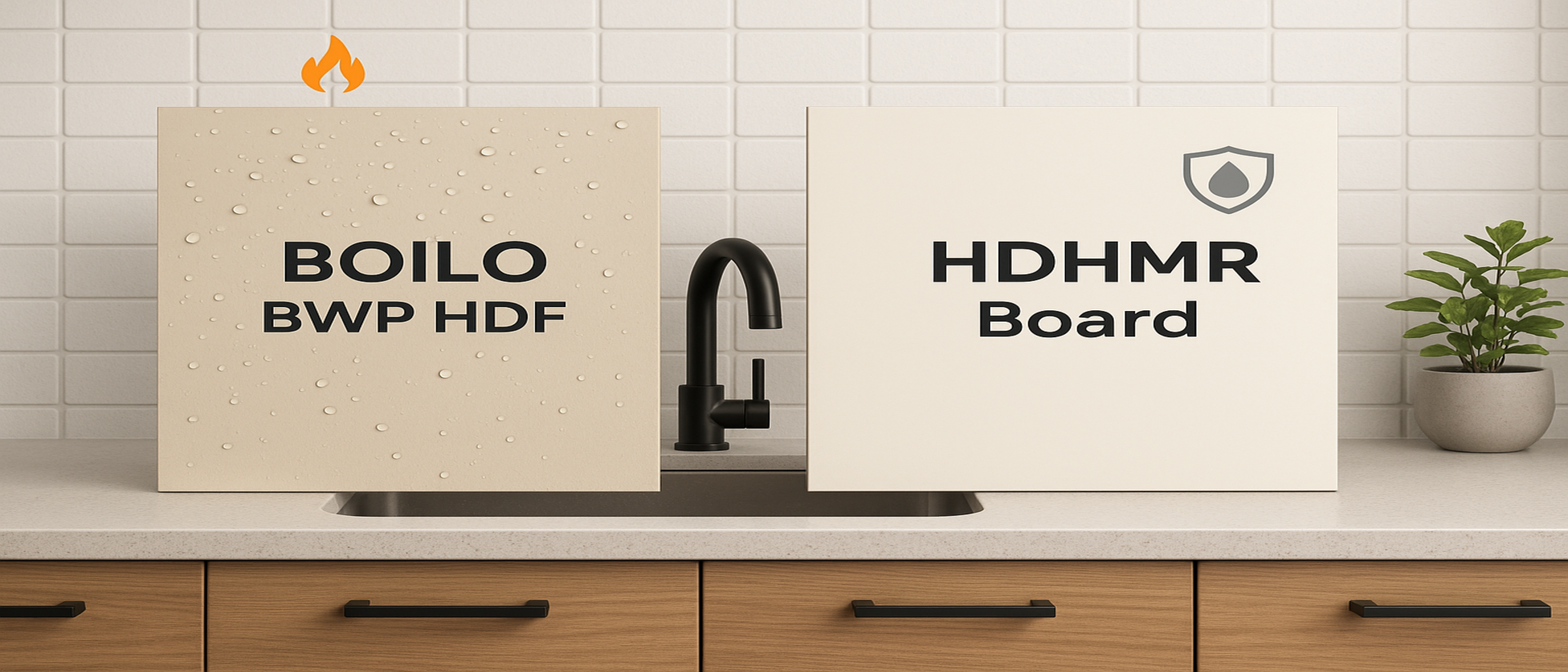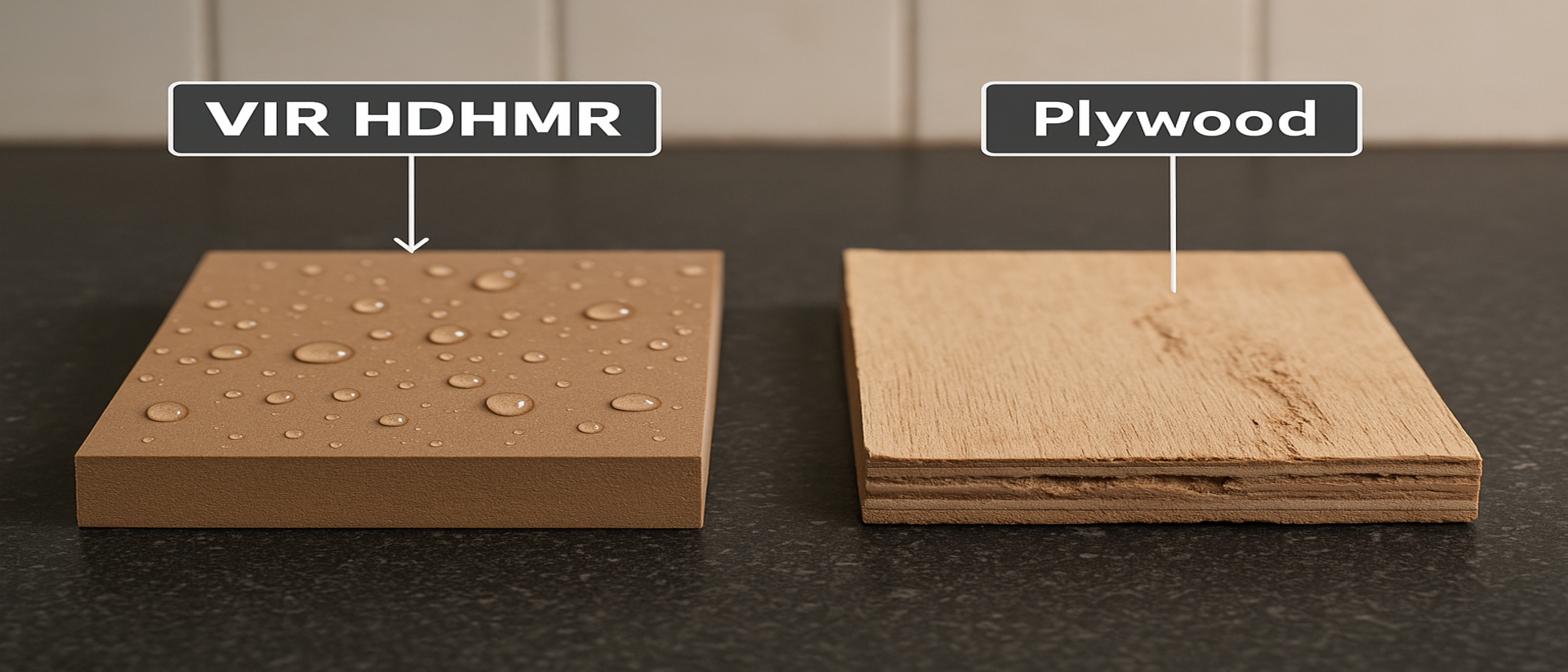HDHMR vs Solid Wood – Can Engineered Board Replace Timber?
Introduction
High‑density high moisture resistant (HDHMR) boards are the latest generation of engineered panels. Manufactured from compressed wood fibres and resins, these boards promise superior screw‑holding capacity, moisture resistance and dimensional stability. Solid wood, on the other hand, has been used for centuries – prized for its natural grain and longevity. With furniture buyers increasingly torn between sustainability, cost and performance, comparing HDHMR and traditional timber is more relevant than ever. This article explores whether engineered boards can genuinely substitute solid wood by examining technical specifications, prices, durability, aesthetics and value for money.
Technical Specs & 2025 Price Comparison
The table below summarises the key metrics that matter when choosing between HDHMR and natural timber. Data for HDHMR is drawn from recent price guides and manufacturer specifications, while solid wood figures reference teak and other premium hardwoods commonly used in Indian furniture.
|
Metric |
HDHMR Board (Engineered) |
Solid Wood (e.g. Teak) |
Notes |
|
Density |
~780–900 kg/m³ (depending on brand) |
~650–750 kg/m³ for premium hardwoods |
Higher density gives HDHMR strong screw‑holding and a smooth finish. |
|
Available thicknesses |
6–25 mm (plain and pre‑laminated) |
Typically 20–50 mm for planks; custom sizes for logs |
HDHMR boards come in standard 8×4 ft sheets, while solid wood planks vary. |
|
Finish options |
Factory pre‑laminated, plain (paintable) or veneered; consistent colour |
Natural grain, oil or lacquer finish; each piece unique |
HDHMR requires laminates or veneers for aesthetics; solid wood offers inherent beauty. |
|
Moisture resistance |
Engineered to be moisture‑ and termite‑resistant |
Susceptible to swelling, warping and termite attack without treatment |
HDHMR uses resins and waxes for water resistance. |
|
Price (approx. 2025) |
₹50–110 per sq ft depending on thickness and brand |
₹7,500–9,000 per cubic foot for top‑grade teak |
Converting ₹7,500 per ft³ to a 25 mm plank yields ~₹625 per sq ft, making solid wood substantially costlier. |
|
Sustainability |
Utilises wood waste and fibres; lower environmental impact |
Requires harvesting mature trees; supply chain concerns |
HDHMR can be more eco‑friendly when sourced responsibly. |
Takeaways
· Affordability: HDHMR is significantly cheaper per usable surface area. Premium hardwood planks can cost six to eight times more than engineered boards.
· Dimensional stability: Because boards are compressed and bonded, they resist warping and swelling better than solid wood.
· Natural aesthetic: Solid wood’s unique grain pattern cannot be truly replicated. Veneers or laminates on HDHMR attempt to mimic this look.
Performance Analysis: Strength, Durability & Moisture Resistance
Modern HDHMR panels are engineered for performance. The compression process yields a dense, homogeneous core that offers excellent screw‑holding capacity and surface smoothness. Moisture and termite resistance are achieved by impregnating fibres with resins and additives. This means the boards can withstand humid kitchens or bathrooms without swelling or delaminating. HDHMR boards also feature antibacterial and antiviral treatments on some brands (e.g., Action Tesa’s ViroKill technology), an advantage in healthcare and food‑service environments.
Solid wood has inherent strength due to its fibrous structure, and high‑quality species like teak or sheesham offer excellent durability. Properly maintained wooden furniture can last for generations. However, natural timber is hygroscopic – it absorbs and releases moisture – making it prone to expansion, shrinkage and cracking in fluctuating climates. Hardwoods also attract termites and borers unless chemically treated. Engineered boards like HDHMR avoid many of these issues, though they cannot be sanded and refinished as many times as solid wood.
When comparing impact resistance, solid wood generally withstands dents and heavy loads better. However, high‑density HDHMR boards are strong enough for everyday furniture, cabinetry and wall panels. Screw and nail holding is excellent due to the dense core, while solid wood may split if not pre‑drilled. In terms of longevity, properly installed HDHMR furniture can last 15–25 years; high‑grade timber can exceed 50 years with maintenance. The trade‑off is between lifetime and the cost of initial investment.
Applications / Best Use Cases
HDHMR boards are widely used in modular kitchens, wardrobes, bathroom vanities, wall paneling and partitioning. Their moisture resistance and stability make them ideal for humid environments where standard plywood fails. Pre‑laminated variants reduce finishing time and provide a scratch‑resistant surface, while plain boards can be painted or veneered to match interiors. Because boards are supplied in standard sizes, they are easy to machine with CNC routers for intricate patterns or grooves. For cost‑effective custom furniture, HDHMR offers good value.
Solid wood is favoured for high‑end cabinetry, dining tables, antique‑style furniture and architectural details like mouldings. Its ability to be carved and refinished repeatedly allows craftspeople to create heirloom pieces. The material’s weight and tactile warmth also lend gravitas to statement furniture. However, using solid wood throughout a kitchen or wardrobe can strain budgets. Many designers now combine hardwood fronts with engineered cores to balance aesthetics and cost.
Design & Aesthetic Differences
HDHMR boards offer a uniform surface free of knots and defects. When factory‑laminated, they feature a wide variety of colours and textures, including wood‑grain prints, solid colours and abstract patterns. This flexibility allows homeowners to match modern minimalist interiors or replicate natural timber at a fraction of the price. Veneering an HDHMR core with real wood veneer gives a premium appearance while retaining dimensional stability.
Solid wood’s appeal stems from its natural grain, warmth and the patina it develops over time. Each plank is unique; variations in colour and grain pattern add character and authenticity. Furniture made entirely from timber often becomes more beautiful with age as the surface oxidises and gains depth. However, the same uniqueness means matching grain across panels can be challenging, and maintaining a consistent finish requires regular care. Design‑wise, solid wood is often the choice for classic or rustic themes, while HDHMR suits contemporary and functional aesthetics.
Cost vs Value Assessment
When evaluating cost, it is clear that HDHMR boards provide an economical solution for most household and commercial projects. Standard 12 mm boards cost around ₹75–95 per sq ft, while 18 mm boards fall between ₹90–110 per sq ft. Premium solid wood such as Burma teak ranges from ₹7,500 to ₹9,000 per cubic foot—roughly ₹600–700 per sq ft for a 25 mm thick panel—before cutting, wastage and finishing costs are considered. Even mid‑range domestic hardwoods cost significantly more than engineered boards.
However, value is not solely determined by price. Solid wood furniture often retains or even increases its value over decades, especially when crafted from rare species. It can be repaired, refinished and handed down generations. HDHMR, while durable, has a finite life; once the surface is compromised, repair options are limited. For rental properties, quick‑turn interiors or projects with tight budgets, HDHMR delivers a high return on investment. For heirloom pieces or luxury projects, solid wood may justify the higher cost.
Environmental considerations also play into value. HDHMR utilises wood waste and small diameter timber, making it a sustainable alternative when certified by credible bodies. Choosing plantation‑grown solid wood from responsible suppliers also supports sustainable forestry. Buyers should look for certifications such as FSC or PEFC regardless of material.
Buyer’s Checklist / Expert Advice
Before choosing between HDHMR and solid wood, consider the following tips:
1. Assess application: For kitchens, bathrooms or wardrobes exposed to humidity, HDHMR’s moisture resistance is invaluable. For statement furniture or areas where aesthetics and longevity are paramount, solid wood may be worth the investment.
2. Check thickness and density: Opt for boards with a density above 780 kg/m³ and thickness suitable for the job—18 mm for cabinets and shelves, 12 mm for drawer sides, etc. Thicker panels improve strength but increase cost.
3. Look for certifications: Reputable brands should provide emission ratings (E0/E1) and warranties. Brands like Action Tesa, Century Ply and Greenpanel offer long warranties and anti‑bacterial technologies.
4. Plan for finishing: Decide whether you will use pre‑laminated HDHMR or apply veneers/laminates. For solid wood, factor in sanding, polishing and periodic maintenance.
5. Compare total cost of ownership: Consider installation, hardware, finishing and long‑term maintenance. HDHMR often saves on finishing labour but cannot be refinished extensively.
6. Work with professionals: Proper machining and edge sealing are crucial to achieving the best performance from both HDHMR and solid wood. Hire experienced carpenters or modular furniture providers.
FAQs
Is HDHMR better than solid wood for kitchen cabinets?
For moisture‑prone areas like kitchens, HDHMR offers clear advantages. Its dense structure and water‑resistant additives prevent swelling and delamination, while termite resistance reduces long‑term maintenance. Solid wood must be carefully seasoned and sealed to avoid warping and is significantly more expensive. However, some homeowners prefer solid wood fronts for their unique look; combining solid wood doors with HDHMR carcasses can offer a balanced solution.
How long does HDHMR furniture last?
With proper installation and care, HDHMR furniture can last 15–25 years. Dense boards with low formaldehyde emissions and good lamination ensure longevity. Avoid prolonged water exposure on cut edges and use edge banding to seal joints. While HDHMR cannot be sanded and refinished as often as solid wood, modern finishes are durable enough for everyday use.
Is solid wood furniture worth the higher price?
Solid wood pieces are an investment. High‑quality timber furniture can last for generations, gain character with age and often appreciate in value. If you are seeking heirloom pieces or bespoke carpentry with intricate carving, solid wood’s tactile warmth and reparability justify the cost. For short‑term or cost‑sensitive projects, HDHMR or a hybrid approach may be more practical.
Can HDHMR boards be refinished like solid wood?
HDHMR boards are typically finished with laminates or paints. Minor scratches can be sanded and refinished, but the board cannot be stripped and re‑polished repeatedly like solid wood. Real wood veneer over HDHMR can be re‑sanded lightly, but caution is needed to avoid sanding through the veneer. Always follow manufacturer guidelines.
Are HDHMR boards eco‑friendly?
HDHMR boards utilise wood waste and rapid‑growth fibres, reducing the need for large logs. Many brands also use low‑emission resins (E0/E1) and offer antibacterial or antiviral treatments. However, some resins may contain formaldehyde; always check emission ratings and certifications. Solid wood can be eco‑friendly if sourced from sustainable plantations.
How do I maintain HDHMR furniture?
Clean surfaces with a damp cloth and mild detergent. Avoid soaking edges and use coasters or mats under hot utensils. For pre‑laminated boards, avoid abrasive cleaners that could scratch the surface. Edge banding helps seal exposed edges; replace any damaged banding promptly to maintain moisture resistance.
Conclusion
HDHMR boards have matured into a reliable alternative to solid wood for most interior applications. Their high density, moisture resistance and affordability make them ideal for modern kitchens, wardrobes and commercial fittings. Solid wood retains its unique beauty and longevity but commands a premium price and requires diligent maintenance. Ultimately, the best choice depends on your project’s budget, aesthetic goals and desired lifespan. Many homeowners opt for a hybrid solution: engineered cores with natural wood accents. Ready to explore HDHMR options? Request a quote or read our other comparisons like HDHMR vs Plywood to make an informed decision.
Disclaimer: This article is generated using AI-assisted research and is intended for informational purposes only. While we strive for accuracy, readers are advised to verify all technical, pricing, and brand-specific details with official sources. hdhmr.in is not liable for any decisions made based on this content.




